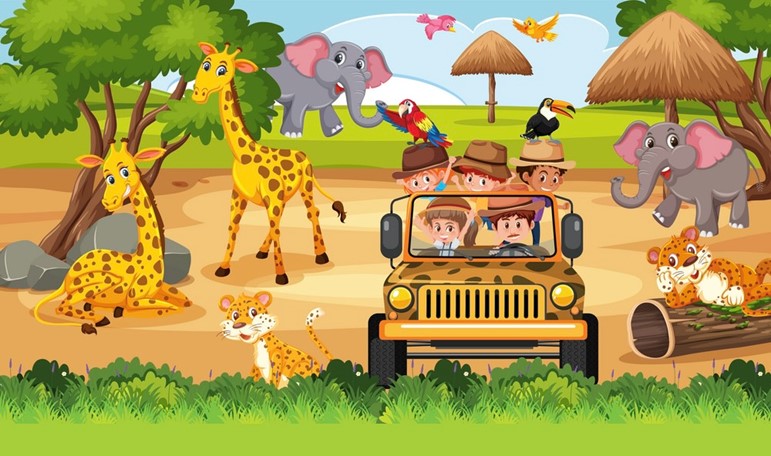Certain trips require advance planning.

Some trips can be pulled off last minute, but many travel experiences require a bit more time to plan. If you thinking about one of the following trips for next year (or even the following), you may want to start planning now.
1. Intimate tours with limited space or trips likely to sell out
Some trips are designed to be shared with as few folks as possible, allowing for less wear on fragile spaces and easier maneuvering within small vessels and vehicles. By nature, their diminutive size makes them a scarce commodity; rather than miss these boats, tours, and adventures, you’ll want to get ahead of the (big) game.
Wildlife safaris and treks
Rwanda, Uganda, and the Republic of Congo generally allow only eight visitors per gorilla trek. Such small groups enable the gorillas to relax, put less stress on delicate mountain and lowland flora, and lower the risk of passing along human diseases to the primates, with whom we share 98% of our DNA. Small groups, though, equal big demand.
During Southern and East Africa’s dry seasons, wildlife-viewing conditions are in their prime, offering minimal mud, cooler temperatures, and low grass cover. The dry season in Botswana’s Okavango Delta and South Africa’s Great Kruger area lasts May through October, while in Tanzania’s Serengeti and Ngorongoro Crater, it’s July through September. The most sought-after safari camps here operate within protected wildlife preserves with a limited number of beds, so be sure to plan accordingly.
Small boat cruises
Both a Nile dahabiya tour (on an elegant Egyptian sailboat) and a Kerala backwater journey on a kettuvallam (a South Indian houseboat) offer amazing, often remote scenery at a leisurely pace. Intimate vessels like these have few beds per sailing, though, so if you want to travel slowly upon them, you’ll have to move fast.
How far in advance you should plan: To ensure your spot on these limited-space adventures, be prepared to book nine months to one year ahead, if not more.
2. Trips that include a lottery or application to attend
Some special places in the US inspire so much interest that controlling their visitor flow becomes vital to their existence. Enter the need for lotteries and applications, many of which are handled by Recreation.gov.
Hikes in state and national parks
The roughly 15-mile, 4,200-foot trip to the summit of Yosemite’s epic Half Dome requires permits for day hikers seven days a week when its 400 feet of assistance cables are up, which is normally the Friday before Memorial Day through the second Tuesday in October. Only 225 day hikers are allowed each day, and the preseason lottery runs from March 1-31.
You’ll also need a permit to hike all of Kauai’s magnificent 22-mile Kalalau Trail, which begins in Hāʻena State Park and provides the only land access to the lush Nā Pali Coast. Hawaii issues only 60 permits a day that allow camping for up to five days along this out-and-back journey; you need to apply through the state’s reservation system.
Natural wonders
Undulating along five round-trip miles through Arizona’s Paria Canyon-Vermilion Cliffs Wilderness, the red-sandstone canyon known as The Wave requires a permit to visit. Of the 64 daily permits allowed, 48 are posted to an online lottery each day, four months in advance of their visiting date.
Within another red-rock canyon in Arizona, the stunning 50-foot Havasu Falls tumble from limestone cliffs into gleaming teal pools. This natural attraction is on land administered by the Havasupai Tribe, who don’t allow visitors to day-hike the 10-mile one-way trail or book a commercial tour, but instead require a permit to stay overnight in their on-site campground. To reserve your camping permit, you’ll have to take your best shot online on February 1, when that year’s reservations open (and will be gone within hours).
National Park lodges
These are some of America’s most sought-after stays, and competition for rooms in popular parks like Yellowstone, Glacier, and Acadia can be fierce. On a smaller scale, the 16-room Brooks Lodge is Alaska’s Katmai National Park’s only indoor lodging near the Brooks Falls bear viewing action during the salmon spawn and is only open from June 1 to mid-September each year. To enter the Brooks Lodge lottery, apply online between December 1-31 of the prior year.
On the floor of the Grand Canyon, Phantom Ranch’s nine updated 1920s cabins (each with two bunk beds) are made available only by lottery. Apply online 14 months in advance of your desired visit, and note that each applicant can only book up to four consecutive nights for up to nine guests. About 10 miles below the canyon rim, Phantom Ranch is reachable only by foot, mule ride, or river raft; the latter requires a river permit via another lottery, posted February 1.
How far in advance you should plan: Permits for most of these all-American attractions require reservations four months to a year in advance.
3. Trips that are especially far and/or expensive
There are some once-in-a-lifetime adventures that require a healthy lead time (and bank account) to get all your ducks (or blue-footed boobies) in a row. Here are just a few:
The Galapagos Islands
Launched throughout the year on ships that carry anywhere between 10 and 100 passengers, guided sailing trips to the remote Galapagos Islands can last anywhere from 5 to 16 nights and cost between $5,000 and $12,000 per person. Plus, you’ll lose almost two days of travel time just getting to and from your port in Ecuador (either Quito or Guayaquil, Ecuador). Booking your trip as far out as possible will help you get the outfitter, ship, and cabin of your choice, likely at a discount, while also accruing the travel time you’ll need to view the wildlife unique to the islands.
Antarctica
The most common way to reach the Antarctic Peninsula is to first fly to the southern tip of South America, then brave a 48-hour sail along the choppy Drake Passage; exploring Antarctica for five days requires you to spend nine to eleven days traveling. Sure, you could just show up in the port city of Ushuaia, Argentina, and try your luck snagging a last-minute boat ride, but only if you can risk blowing extra days off work and extra cash on hotels. Just 50 small ships sail during Antarctica’s short travel season (November to March), and planned itineraries average $9,000 per person, so putting down a deposit way ahead ensures you don’t exceed your budget or waste precious vacation time.
Luxury train journeys
Some of the most sought-after rail journeys are also the most expensive, costing upwards of $1,000 a night. There are limited bookings aboard glamorous trains like Europe’s Venice-Simplon Orient Express; The Ghan, which travels 1,851 miles across Australia; and the Palace on Wheels, with its seven-day trip across India.
How far in advance you should plan: At least a year ahead to be (more) sure of getting a good seat or cabin.
4. Trips you need a lot of preparation for
Adventures that require you to be in good shape are great ways to inspire a fitness plan, but a fitness plan takes time to yield results. Give yourself plenty of lead time for trips like those below that are physically demanding or otherwise require some preparation for your health.
Mountain climbing
Dreaming of scaling a gargantuan peak like Everest or Kilimanjaro, or even an American fourteener like Denali? You’ll need to secure any necessary permits, research conditions on your mountain of choice, gather the right gear, and train both for strength and endurance. Before booking your travel, book an appointment with your doctor and/or a trainer to determine your fitness baseline; this will give you a better idea of your planning timeline.
Multi-day or multi-week hikes
You’ll also want to check your fitness level before attempting a long (and I mean long) walk like the 96-mile West Highland Way in Scotland, the 2,000-plus-mile Appalachian Trail, or the 500-mile Camino de Santiago, which runs from the Basque region of France to Santiago de Compostela in Spain. You’ll want to break in your boots and make reservations at hostels (to be assured of a bed each night) as well as get in shape. You can do shorter sections of any long-distance hike, but you’ll still want to be in shape before you go.
Vacations that require vaccines
Before you book a trip out of the country, first check the Center for Disease Control’s list of destinations to see if you’ll need vaccines for anything from yellow fever to hepatitis and cholera in order to travel. If you do need vaccines, you’ll have to find a clinic, determine how many rounds of shots are required and how far in advance, and then make sure you have the proper paperwork to present at airports. It pays to sort out these details before you even decide on travel dates, much less purchase the expensive portions of your trip.
How far in advance you should plan: As soon as the idea of one of these trips pops into your head, check in with a health professional for a sense of how long you’ll need to get strong and/or vaccinated, then allow yourself at least six months before you travel.
5. Trips to a major event
When an experience can only be had once a year—or even more rarely—it’s bound to make a lot of bucket lists. And because the dates for events like those listed below are publicized far in advance, only the most organized early birds will score the best flights, hotel locations, and more. Think Carnival in Rio, Mardi Gras in New Orleans, the Olympic Games, cherry blossom season in DC or Japan, or a solar eclipse.
How far in advance you should plan: For any of these events, aim to book your travel arrangements at least 12-18 months in advance.
Twist’s Take: Certain trips need advance planning; if you have one of these journeys in mind, pay attention to the calendar!

